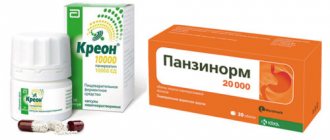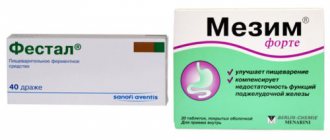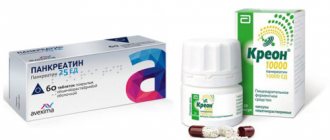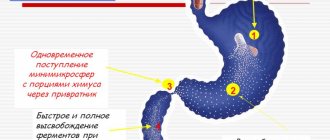Instructions
Deterioration of the excretory (exocrine) function of the pancreas leads to impaired absorption of food and a lack of basic macro- and microelements. Enzyme deficiency is manifested by pain, nausea, diarrhea and other unpleasant symptoms.
To compensate for enzyme deficiency, Festal or Creon is prescribed.
To compensate for enzyme deficiency, Festal or Creon, as well as other pancreatin-based products, are prescribed.
How do they affect the body?
The main active component of Festal and Creon is an extract of pancreatic juice from pigs or cattle - pancreatin. It consists of 3 types of enzymes: lipase, which determines the dosage of all enzyme preparations, amylase and proteinases.
The first of the enzymes is responsible for lipolysis (the breakdown of fats) and the absorption of fat-soluble vitamins in the intestines. Amylase helps break down starch into monosaccharide residues (simple carbohydrates), which are sources of energy. Proteinases ensure the absorption of amino acids from proteins.
With exocrine pancreatic insufficiency, fats, proteins and complex carbohydrates are not completely digested. This leads to hypovitaminosis A, E, K and D3, gastrointestinal disorders and weight loss. It is possible to improve the absorption of macro- and micronutrients only by introducing additional sources of enzymes (Creon, Festal).
Pharmacological effects
Creon capsules dissolve under the action of gastric juice and release many mini-spheres with an enteric coating. The same shell protects units of the drug Festal.
Creon capsules dissolve under the action of gastric juice and release many mini-spheres with an enteric coating.
When the drugs reach the intestines, the coating dissolves and releases proteases, lipase and amylase. They break down incoming nutrients and ensure their absorption in the small intestine.
Festal additionally contains hemicellulase, bile extract and bile acids. Hemicellulase partially breaks down fiber, which helps reduce gas formation in the intestines. Bile components stimulate the secretion of bile and its own lipase, which facilitate the absorption of fatty acids.
What is the difference
Creon promotes better absorption of nutrients in the small intestine and the breakdown of proteins, lipids and carbohydrates. Festal stimulates digestion due to its choleretic effect. This is necessary when pancreatitis is combined with congestion in the gallbladder, which occurs in most cases. The drug also stimulates the breakdown of plant fiber, which reduces the risk of increased gas formation.
Creon promotes better absorption of nutrients in the small intestine and the breakdown of proteins, lipids and carbohydrates.
Differences and similarities between the two drugs
The differences between Creon and Festal are observed in the following:
- Dosage of enzymes. The enzyme content in Creon is higher than in Festal. At the minimum dosage of lipase in the drug Creon (10,000 units), the content of amylase and proteases is 8,000 units and 600 units. For Festal, the concentration of these enzymes is 6000 IU, 4500 IU and 300 IU, respectively.
- Availability of additional components. The effect of Creon is based only on the pharmacological effects of pancreatin, and Festal additionally contains hemicellulase and bile extracts.
- Release form and particle sizes of the drug. Creon is available in the form of capsules (the shell is soluble in gastric juice) filled with microspheres with pancreatin. Festal is supplied in the form of dragees with an acid-resistant coating.
- Number of contraindications. Festal has a greater number of indications: additional components of this medicine can cause exacerbation of other gastrointestinal diseases.
- Cost of medicine. The price of Creon (in the minimum dosage) is 2-2.5 times higher than the cost of Festal.
We recommend reading: What to choose: Losek Maps or Omez?
Which is better: Festal or Creon?
| A drug | Advantages | Flaws |
| Creon | Several dosage options Use for children, pregnant women, patients with liver dysfunction, etc. Possibility of dividing small doses of enzymes if necessary | High cost Presence of side effects when taking high doses of lipase |
| Festal | Use for disorders of the formation and movement of bile, certain liver diseases Lower dosage of enzymes (convenient dosage regimen for preventive purposes) Low cost | Less uniform distribution in the intestines, reduced effectiveness More contraindications and adverse reactions Inability to use for children under 3 years of age and patients with swallowing disorders |
Comparison of safety of Creon 1000i and Festal
The safety of a drug includes many factors.
At the same time, Creon has 1000 and is quite similar to Festal. It is important where the drug is metabolized: drugs are excreted from the body either unchanged or in the form of products of their biochemical transformations. Metabolism occurs spontaneously, but most often involves major organs such as the liver, kidneys, lungs, skin, brain and others. When assessing the metabolism of Creon 1000i, as well as Festal, we look at which organ is the metabolizing organ and how critical the effect on it is.
The risk-benefit ratio is when the prescription of a drug is undesirable, but justified under certain conditions and circumstances, with the obligatory observance of caution in use. At the same time, Creon 1000 has no risks when used, just like Festal.
Also, when calculating safety, it is taken into account whether only allergic reactions occur or possible dysfunction of the main organs. In other matters, as well as the reversibility of the consequences of using Creon 1000i and Festal.
Indications for use
Enzymatic agents are used for the following indications:
- enzyme deficiency in elderly patients, against the background of chronic pancreatitis, cystic fibrosis and Shwachman-Diamond syndrome;
- malignant neoplasia of the pancreas and bile ducts;
- condition after irradiation or complete or partial removal of the stomach, gall bladder, pancreas;
- other gastrointestinal diseases that complicate the function of the digestive gland (cirrhosis, gastrostasis, cholestatic inflammation of the liver, etc.);
- microbial overgrowth in the small intestine;
- pain under the left ribs, heaviness in the abdomen, nausea and diarrhea due to poor nutrition;
- preparation for radiography or ultrasound of the abdominal organs.
The following pathologies may be indications for taking Festal:
- disturbances in the movement of bile (with GIB, malabsorption, etc.);
- disorder of neurohumoral regulation of the formation and separation of bile in chronic gastrointestinal diseases (gastritis, gastroduodenitis, cholecystitis);
- alcoholic and toxic liver damage.
For cystic fibrosis and digestive disorders during pregnancy, Festal is used with caution.
Festal is taken for alcoholic and toxic liver damage.
Comparison of side effects of Creon 1000i and Festal
Side effects or adverse events are any adverse medical event that occurs in a subject after administration of a drug.
Creon 1000 and the state of undesirable effects are almost the same as Festal. They both have few side effects. This implies that the frequency of their occurrence is low, that is, the indicator of how many cases of an undesirable effect of treatment are possible and registered is low. The undesirable effect on the body, the strength of influence and the toxic effect of Creon 1000 is similar to Festal: how quickly the body recovers after taking it and whether it recovers at all.
Directions for use and dosage
Enzymatic agents are taken during or after meals. 1/3-1/2 doses can be taken immediately before meals, if the number of units of medication is more than 1. Capsules and dragees are swallowed whole, with plenty of water.
For hypofunction of the digestive gland, the dose of Creon is from 25,000 to 80,000 units (calculated for lipase). This corresponds to 2-8 capsules depending on the dosage.
For cystic fibrosis, the daily dosage of the drug is selected according to age and weight: for patients under 4 years of age, the recommended initial dose is 1000 IU of lipase per 1 kg of body weight, for patients over 4 years old - 500 IU per 1 kg. If clinical improvement is unsatisfactory, the dosage is increased (but not more than 10,000 units/kg).
Festal is prescribed in a dose of 1-2 tablets 3 times a day throughout therapy. To prepare for the study, it is recommended to drink 2 tablets 2-3 times a day for 2-3 days before the procedure.
Comparison of the effectiveness of Creon 1000i and Festal
Creon has 1000 and is more effective than Festal - this means that the ability of the medicinal substance to provide the maximum possible effect is different.
For example, if the therapeutic effect of Creon is 1000 or more pronounced, then with Festal it is impossible to achieve this effect even in large doses.
Also, the speed of therapy is an indicator of the speed of the therapeutic action; Creon 1000i and Festal are also different, as is bioavailability - the amount of a medicinal substance reaching the site of its action in the body. The higher the bioavailability, the less it will be lost during absorption and use by the body.
special instructions
Products based on enzymes and bile are prescribed taking into account the age and health status of the patient.
Pregnancy and lactation
Prescribing both drugs during pregnancy is possible only if the benefit to maternal health is significantly higher than the risk of problems in the fetus. Large doses of enzymes (Creon) can negatively affect the absorption of vitamin B9 and iron, which are necessary for the growth and development of the child.
Pancreatin does not have a toxic effect on the body of a newborn during lactation.
Childhood
The use of both drugs to treat children is acceptable. Therapy should be carried out in accordance with the prescriptions of a gastroenterologist or pediatrician. When taking pancreatin in high doses, children may develop constipation and perianal irritation.
Dragee Festal is prohibited for use in children under 3 years of age.
Elderly age
Creon is used to treat patients over 60 years of age without dose adjustment due to chronic pathologies of internal organs.
Festal is not prescribed to patients with liver failure, cholelithiasis and a number of other pathologies that can be observed in older people.
For swallowing problems in young children, bedridden and elderly patients, Creon capsules should be opened and microspheres added to soft food or acidic drinks - yogurt and juice (with a pH less than 5.5). It is prohibited to divide and crush the dragees.
Kreon® 25000 (Kreon® 25000)
Inside.
Doses of the drug are selected individually depending on the severity of the disease and the composition of the diet.
Capsules should be taken during or immediately after each meal (including snacks), swallowed whole, not broken or chewed, and washed down with sufficient liquid.
If swallowing is difficult (for example, in young children or elderly patients), the capsules are carefully opened and the minimicrospheres are added to soft, non-chewable food that has a sour taste (pH < 5.5), or taken with a liquid that also has a sour taste ( pH < 5.5). For example, minimicrospheres can be added to applesauce, yogurt, or fruit juice (apple, orange, or pineapple) with a pH less than 5.5. It is not recommended to add the contents of the capsules to hot food. Any mixture of minimicrospheres with food or liquid cannot be stored and should be taken immediately after preparation.
Crushing or chewing minimicrospheres, or mixing them with food or liquid with a pH greater than 5.5, can destroy their protective enteric coating. This can lead to early release of enzymes in the mouth, reduced effectiveness and irritation of the mucous membranes. You need to make sure that there are no mini-microspheres left in your mouth.
It is important to ensure that the patient maintains adequate fluid intake, especially if there is increased fluid loss. Inadequate fluid intake may cause or worsen constipation.
Dose for adults and children with cystic fibrosis
- The dose depends on body weight and should be at the beginning of treatment 1000 lipase units/kg at each meal for children under four years of age and 500 lipase units/kg at meals for children over four years of age and adults.
— The dose should be determined depending on the severity of symptoms of the disease, the results of control of steatorrhea and maintenance of adequate nutritional status.
- In most patients, the dose should remain less than or not exceed 10,000 lipase units/kg body weight per day or 4000 lipase units/g fat consumed.
Dose for other conditions accompanied by exocrine pancreatic insufficiency
The dose should be set taking into account the individual characteristics of the patient, which include the degree of digestive insufficiency and the fat content of food. The dose required by the patient with the main meal varies from 25,000 to 80,000 units of lipase, and half the individual dose when taking a snack.
In children, the drug should be used as prescribed by a doctor.
Contraindications to the use of Festal and Creon
General contraindications to taking Festal and Creon are:
- acute pancreatitis;
- exacerbation of inflammation of the pancreas;
- individual sensitivity to the components of the drug.
Festal is also contraindicated in the following pathologies:
- liver failure, chronic inflammation (hepatitis), precoma and coma of the liver;
- high concentration of bilirubin;
- obstructive jaundice, empyema and gallstones;
- intestinal obstruction, diarrhea;
- peptic ulcer and erosion of the stomach and duodenum;
- duodenogastric reflux.
How to take Festal and Creon drugs
Festal must be taken with every meal. The tablets cannot be crushed, but must be swallowed whole with water. The maximum daily dose is 6 pcs. It is not recommended to increase the amount of the drug without a doctor's prescription. For digestive disorders associated with poor nutrition, the course of therapy may not exceed 2-3 days. For severe chronic diseases of the pancreas, you will have to take the medicine for several years. The duration of therapy is determined only by the doctor.
Festal stimulates digestion due to its choleretic effect.
The dosage of Creon is selected only by a gastroenterologist. One part of the drug must be taken before meals, and the other during. If necessary, capsules can be opened and added to food. Microspheres cannot be combined with acidic foods, otherwise their shell will collapse. The contents of the capsules also cannot be chewed, but can be swallowed whole. The daily amount of the drug should not be more than 10,000 units/kg. If necessary, the medication can be taken in combination with other medications, but it is advisable to consult a doctor first.









